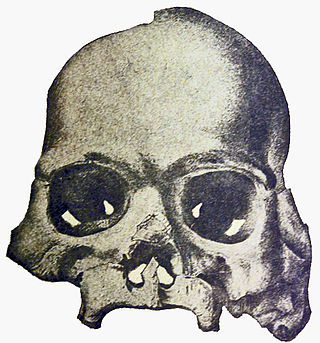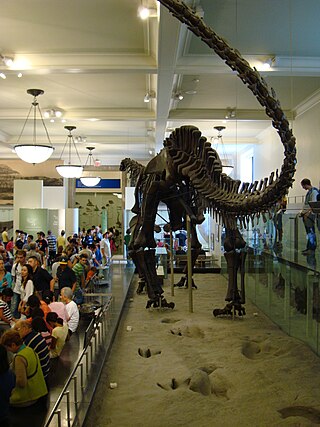Related Research Articles

An out-of-place artifact is an artifact of historical, archaeological, or paleontological interest found in an unusual context, which challenges conventional historical chronology by its presence in that context. Such artifacts may appear too advanced for the technology known to have existed at the time, or may suggest human presence at a time before humans are known to have existed. Other examples may suggest contact between different cultures that is hard to account for with conventional historical understanding.

Young Earth creationism (YEC) is a form of creationism which holds as a central tenet that the Earth and its lifeforms were created by supernatural acts of the Abrahamic God between approximately 6,000 and 10,000 years ago. In its most widespread version, YEC is based on the religious belief in the inerrancy of certain literal interpretations of the Book of Genesis. Its primary adherents are Christians and Jews who believe that God created the Earth in six literal days, in contrast with old Earth creationism (OEC), which holds literal interpretations of Genesis that are compatible with the scientifically determined ages of the Earth and universe and theistic evolution, which posits that the scientific principles of evolution, the Big Bang, abiogenesis, solar nebular theory, age of the universe, and age of Earth are compatible with a metaphorical interpretation of Genesis.

Arthur Ernest Wilder-Smith, FRSC, more commonly known as A. E. Wilder-Smith, was a British organic chemist and young Earth creationist.
Carl Edward Baugh is an American young Earth creationist. Baugh has claimed to have discovered human footprints alongside dinosaur footprints near the Paluxy River in Texas. Baugh promoted creationism as the former host of the Creation in the 21st Century TV program on the Trinity Broadcasting Network.

Xiphactinus is an extinct genus of large predatory marine bony fish that lived during the Late Cretaceous. Species in the genus bore a superficial resemblance to a gargantuan, fanged tarpon.

Dinosaur Valley State Park is a state park near Glen Rose, Texas, United States.

The Paluxy River, also known as Paluxy Creek, is a river in the U.S. state of Texas. It is a tributary of the Brazos River. It is formed by the convergence of the North Paluxy River and the South Paluxy River near Bluff Dale, Texas in Erath County and flows a distance of 29 miles (47 km) before joining the Brazos just to the east of Glen Rose, Texas in south central Somervell County.

The Calaveras Skull was a human skull found by miners in Calaveras County, California, which was purported to prove that humans were in North America as early as the Pliocene, and used to support the idea the humans, mastodons, and mammoths had coexisted. It was later revealed to be a hoax, although it is now known that humans, mastodons, and mammoths had indeed coexisted, but much more recently. Coincidentally, calaveras is the Spanish word for "skulls".

A fossil track or ichnite is a fossilized footprint. This is a type of trace fossil. A fossil trackway is a sequence of fossil tracks left by a single organism. Over the years, many ichnites have been found, around the world, giving important clues about the behaviour of the animals that made them. For instance, multiple ichnites of a single species, close together, suggest 'herd' or 'pack' behaviour of that species.

The Glen Rose Formation is a shallow marine to shoreline geological formation from the lower Cretaceous period exposed over a large area from South Central to North Central Texas. The formation is most widely known for the dinosaur footprints and trackways found in the Dinosaur Valley State Park near the town of Glen Rose, Texas, southwest of Fort Worth and at other localities in Central Texas.

Leonard Brand is a Seventh-day Adventist creationist, biologist, paleontologist, and author. He is a professor and past chair of Loma Linda University Department of Earth and Biological Sciences.

The Creation Evidence Museum of Texas, originally Creation Evidences Museum, is a creationist museum in Glen Rose in Somervell County in central Texas, United States. Founded in 1984 by Carl Baugh for the purpose of researching and displaying exhibits that support creationism, it portrays the Earth as six thousand years old and humans coexisting with dinosaurs, disputing that the Earth is approximately 4.5 billion years old and dinosaurs became extinct 65.5 million years before human beings arose.

The Mt. Blanco Fossil Museum is a creationist museum in Crosbyton, Texas, United States, opened in 1998. Its motto is "Digging up the facts of God's Creation: One fossil at a time."

A creationist museum is a facility that hosts exhibits which use the established natural history museum format to present a young Earth creationist view that the Earth and life on Earth were created some 6,000 to 10,000 years ago in six days. These facilities generally promote pseudoscientific biblical literalist creationism and contest evolutionary science. Their claims are dismissed by the scientific community.

The Moenave Formation is a Mesozoic geologic formation, in the Glen Canyon Group. It is found in Utah and Arizona.

Paleontology in Utah refers to paleontological research occurring within or conducted by people from the U.S. state of Utah. Utah has a rich fossil record spanning almost all of the geologic column. During the Precambrian, the area of northeastern Utah now occupied by the Uinta Mountains was a shallow sea which was home to simple microorganisms. During the early Paleozoic Utah was still largely covered in seawater. The state's Paleozoic seas would come to be home to creatures like brachiopods, fishes, and trilobites. During the Permian the state came to resemble the Sahara desert and was home to amphibians, early relatives of mammals, and reptiles. During the Triassic about half of the state was covered by a sea home to creatures like the cephalopod Meekoceras, while dinosaurs whose footprints would later fossilize roamed the forests on land. Sand dunes returned during the Early Jurassic. During the Cretaceous the state was covered by the sea for the last time. The sea gave way to a complex of lakes during the Cenozoic era. Later, these lakes dissipated and the state was home to short-faced bears, bison, musk oxen, saber teeth, and giant ground sloths. Local Native Americans devised myths to explain fossils. Formally trained scientists have been aware of local fossils since at least the late 19th century. Major local finds include the bonebeds of Dinosaur National Monument. The Jurassic dinosaur Allosaurus fragilis is the Utah state fossil.

The London Hammer is a name given to a hammer made of iron and wood that was found in London, Texas in 1936. Part of the hammer is embedded in a limey rock concretion, leading to it being regarded by some as an anomalous artifact, asking how a man-made tool could come to be encased in Lower Cretaceous rock.

The 20th century in ichnology refers to advances made between the years 1900 and 1999 in the scientific study of trace fossils, the preserved record of the behavior and physiological processes of ancient life forms, especially fossil footprints. Significant fossil trackway discoveries began almost immediately after the start of the 20th century with the 1900 discovery at Ipolytarnoc, Hungary of a wide variety of bird and mammal footprints left behind during the early Miocene. Not long after, fossil Iguanodon footprints were discovered in Sussex, England, a discovery that probably served as the inspiration for Sir Arthur Conan Doyle's The Lost World.
Glen Jay Kuban is an American computer programmer and independent investigator from Brunswick, Ohio. He is known for his work in Paluxy River dinosaur footprints.
The Meister Print refers to two trilobites in slate that appeared to be crushed in a human shoe print. The print was cited by creationists and other pseudoscience advocates as an out-of-place artifact, but was debunked by palaeontologists as the result of a natural geologic process known as spall formation.
References
- 1 2 3 Kuban, Glen J. (2005). "'Moab Man' - 'Malachite Man'". paleo.cc.
- ↑ Armstrong, John R. (1987). Creation/Evolution Newsletter 7 5:21
- ↑ Kuban, G (1995). "On the Heels of Dinosaurs". TalkOrigins.org. Retrieved 2009-05-25.
- Coulam, Nancy J.; Schroedl, Alan R. (1995). "The Keystone Azurite Mine in Southeastern Utah". Utah Archaeology. 8 (1): 1–12.
- Jim Brandon (1978). Weird America: A Guide to Places of Mystery in the United States. p. 221.